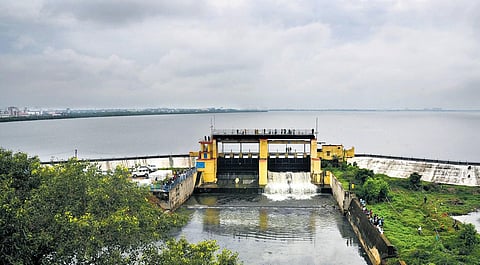

CHENNAI: Even though the Chennai Metropolitan Development Authority decided to protect Redhills Lake, a key source of water for the city, there has been a three-fold jump in buildings in the catchment areas, according to a report by IIT Madras Centre for Urbanisation, Buildings and Environment (CUBE).
Although 27 villages were brought under the safe zone in 1991 and restrictiong imposed on construction activities, the land used for construction activities has increased to 24% in 2023, a massive jump from 7% in 1990, according to the report.
The interim report titled ‘Study on Impact of Urbanisation on Redhills Catchment Area and Measures for its Conversion and Protection from Urbanisation’ prepared by CUBE was submitted to the CMDA recently. With the planning body mulling urban development in the catchment area, the report highlighted the distribution of lands three decades ago.
In 1991, 55% of the total area was demarcated as agricultural land, 21% as water bodies, 9% as open land, 7% as built-up land, 6% as vegetation and 2% as reserve forest. However, agricultural land has shrunk to 33%, while built-up land increased to 24% and open land to 16%. While water bodies remain at 21% of the total area, vegetation and reserve forests each decreased to 1%. The report says the planning body along with local bodies have been issuing permits.
Alterations in land cover patterns and an increase in built-up land point to rapid urban development, with decrease in agricultural lands highlighting the evolving landscape and land utilisation patterns in the specified villages.
The report also points to the presence of heavy metals such as barium, cobalt, chromium and copper in the soil in these villages. It further states that surface soil samples around the area show a slight increase in lead and fluoride levels. However, the water in the reservoir remains safe for drinking purposes. There are heightened concerns over the suitability of groundwater as TDS levels have exceeded the benchmark set by the Bureau of Indian Standards, in many villages.
Groundwater is a major source of water for residential, commercial, industrial and irrigation purposes. High reliance on groundwater points to a potential impact on aquifers, which in turn highlights the negative environmental impact associated with urbanisation and the subsequent damage to the ecology.
Changes in land use patterns suggest an increased demand for infrastructure and housing, the report suggests. With villages seeing a drastic increase in built-up area, the demand for expansion of urban infrastructure to accommodate the growing population comes to the fore.
KP Subramanian, a former professor of urban engineering at Anna University, questioned the intention of the study. “CUBE should study how unauthorized developments have taken place and how the catchment area, which is key for water security, should be safeguarded. The planning body should learn a lesson from the recent disasters and ensure that the catchment areas and flood plains are protected.”